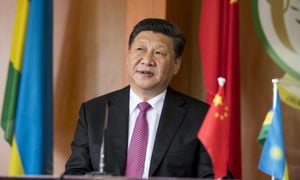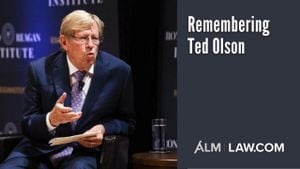Donald Trump is officially back at the helm, ready to launch his second term as President of the United States, and he’s already busy putting together his inner circle. After winning the presidential election against former Vice President Kamala Harris, Trump’s new administration is shaping up with cabinet appointments and policy plans aimed at undoing much of what his predecessor implemented. With enthusiastic loyalists at his side, Trump seems set on steering the nation back to his "America First" agenda.
President-elect Trump’s first significant nominations include some familiar names, signaling his intent to staff his administration with individuals who share his vision and approach. Among his early picks are Rep. Elise Stefanik from New York, who will serve as the ambassador to the United Nations, and Sen. Marco Rubio from Florida, likely to be appointed as secretary of state. Both candidates are staunch supporters of Trump's policies, setting the stage for continuity rather than dissent within the ranks of his foreign policy team, contrasting sharply with the divisions seen during his first term.
Stefanik, at just 40 years old, has transitioned from being seen primarily as a hawkish internationalist to firmly aligning herself with Trump’s more populist foreign policies. Her selection indicates Trump’s prioritization of loyalty over traditional diplomatic experience—a theme evident throughout his cabinet choices. During his announcement, Trump praised Stefanik, calling her “a strong and very smart ‘America First’ fighter,” highlighting her unwavering support since the early days of his campaign. She has become known for her aggressive defense of Trump’s interests, particularly concerning national security and her staunch support of Israel.
On the other hand, Rubio's appointment also speaks volumes about Trump's approach. Initially perceived as more traditional within the GOP, Rubio has adapted his views significantly since his early rivalry with Trump. Today, he emphasizes the need to address threats like China and Russia, reflecting Trump's own perspectives on foreign policy. Rubio, who has taken on roles as the top Republican on key Senate committees, plans to leverage his experience to smooth the way for his confirmation within the Senate. His past critiques of Trump seem to have faded, as he now embraces the former president’s foreign policy angles.
Meanwhile, Trump has chosen well-known media personalities and veterans to lead other significant departments, including Fox News host Pete Hegseth for Secretary of Defense. Hegseth’s prior experience with veterans’ groups aligns with Trump’s commitment to military and veteran issues, continuing his trend of prioritizing loyal supporters across various channels of influence. This approach is not without its critics, as some senators and representatives express concern about the potential for bias over expertise, echoing concerns from Trump’s first term.
But cabinet picks are just one part of the story. Trump's policy agenda for his second term is bold and sweeping. On the first day of his presidency, Trump intends to sign numerous executive orders aimed at dismantling President Biden's legacy—similar to what he did when he took office during his first term. He plans to ramp up immigration enforcement, eliminating programs initiated under Biden and significantly increasing deportations. This is part of his promise to build on border security measures initiated previously, reinvigorated by earlier controversies surrounding illegal immigration.
Under his proposed immigration policies, federal officers would have broader authority to arrest undocumented immigrants, including those without prior criminal records. There’s talk of surging troops to the Mexico border and renewing construction efforts on the border wall. These initiatives signal Trump’s commitment to making border security his top priority, claiming to tackle what he has described as grave threats to national sovereignty and security.
While Trump focuses on immediate policy implementations, he’s also preparing for potential legal challenges to his ambitious plans. Civil rights organizations, many led by Democrats, are poised to contest his administration's moves to abandon policies favoring humanitarian admissions and prioritize harsher penalties for undocumented persons. Activist groups and states, led by Democratic governors, put together coalitions ready to counteract stricter immigration enforcement policies.
Adding to the complexity of his administration is the nomination of Tulsi Gabbard, the former Democratic congresswoman and presidential candidate. Gabbard stated she would be “honored to serve” if invited, emphasizing her recognition of the importance of preventing unnecessary military conflicts. With Gabbard’s left-leaning past and her newfound affiliations with Trump, her appointment, should it come to fruition, could provide a fusion of perspectives within his cabinet.
Now, alongside these challenging policies, Trump’s administration aims to revive pre-Biden practices concerning climate policy. He intends to immediately withdraw from agreements such as the Paris climate accord, pushing back against regulations perceived as hindering American economic growth. This echoes the rhetoric from the campaign trail where he often linked environmental restrictions to job losses and economic downturn.
Trump's administration also promises to reinstate the controversial Schedule F initiative. This proposal enables the dismissal of civil servants deemed unsuitable due to their perceived political biases. Supporters within the GOP view this as necessary to disrupt what they describe as entrenched bureaucracies resistant to reform. Critics, on the other hand, anticipate significant pushback and legal battles, as many see it as undermining the foundation of nonpartisanship intended to guide civil service functions.
Despite some resistance from various factions, Trump’s cabinet and policy directions for his second term outline clear intentions to transform key areas of American governance—and with the backing of seasoned political warriors and loyalists, he seems determined to do so. The stage is set; as Trump prepares to move back to the White House, all eyes will be on how these individuals and their policies start reshaping America once more.
Only time will tell if nurturing loyalty over experience pays off as America navigates through complex global challenges already shaping up on the horizon. The incoming administration appears bold and unapologetic, targeting rapid change and swift action, all coming together to signal Trump's desire to resurrect his vision. With cabinet appointments finalized and plans to enact sweeping executive orders on day one, the transition back to power for Trump is poised to be anything but dull.



